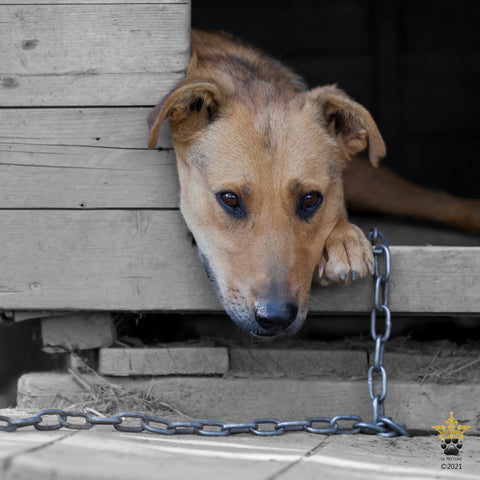Why Chaining Your Dog Is Cruel
Posted on
Picture this: you’re driving by a street when suddenly, you spot a dog chained to a pole in front of an empty house. It’s apparent the dog doesn’t want to be in that situation, and yet the owner is nowhere to be found. What do you do in this situation?
What we just described is also known as “tethering,” or “chaining.” According to the humane society, this means fastening a dog to a stationary object and leaving them unattended. Oftentimes, people are unaware of how much harm this can actually cause their pets.
But why do people chain their dogs in the first place? The most common reasons is because:
- The dog is an escapee, and has attempted to escape their owners on previous occasions.
- The owner is trying to “protect” their dog by keeping them restricted in one area.
- The dog is not housebroken or has trouble behaving indoors, so is kept outside.
However, none of these are proper reasons on why one should keep a dog chained. According to the humane society, dogs are naturally interactive animals, which means long term restraint can have serious physical and psychological impacts on a pooch. Being confined to one place can, over time, make a dog more hostile, aggressive, and anxious. Additionally, a rope or collar around a dog’s neck for long periods of time can damage the skin around the dog’s neck, as well as make the dog more vulnerable to entanglement and strangulation. What’s worse, these dogs are usually also the most prone to negligence by their owners.
Although chaining may not pose a direct threat to humans, an aggressive dog will. If an angsty tethered dog is met with any kind of interaction, it is likely to snap or bite at the object or person. This is what makes dogs that have been chained so dangerous; they are no longer attentive of their behaviors. These dogs will be unable to perceive friend from foe. Unfortunately, their most common victims are children, and in such cases the dogs are immediately put down.
Make sure to read up about your city’s local chaining rules; if there aren’t any rules, then consider bringing this to the attention of city officials and getting it added. If you are concerned about a specific dog, then consider contacting a local animal care and control agency so they can have a discussion with the owners about their pet. Do not try to rescue the dog off the bat; get in touch with the owners first, if possible, and let them know about the dangers of chaining. Additionally, it may not be safe for you to unchain a dog, especially if they are hostile. That being said, remember that not every instance of chaining is dangerous; if the owner is present with the dog or at short distance, and it is apparent that the chaining is very temporary, then there is nothing to worry about.
So keep an eye out for any dogs out there on your next walk or drive, and remember to stay up to date with your research on pet regulations!
